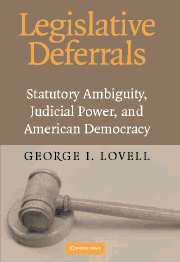Book contents
- Frontmatter
- Contents
- Acknowledgments
- Preface
- 1 Rethinking Judicial Policy Making in a Separation of Powers System
- 2 False Victories: Labor, Congress, and the Courts, 1898–1935
- 3 “As Harmless as an Infant”: The Erdman Act in Congress and the Courts
- 4 Killing with Kindness: Legislative Ambiguity, Judicial Policy Making, and the Clayton Act
- 5 The Norris-LaGuardia Act, for Once: Learning What to Learn from the Past
- 6 Legislative Deferrals and Judicial Policy Making in the Administrative State: A Brief Look at the Wagner Act
- 7 Conclusion
- Reference List
- References
- Index
1 - Rethinking Judicial Policy Making in a Separation of Powers System
Published online by Cambridge University Press: 14 July 2009
- Frontmatter
- Contents
- Acknowledgments
- Preface
- 1 Rethinking Judicial Policy Making in a Separation of Powers System
- 2 False Victories: Labor, Congress, and the Courts, 1898–1935
- 3 “As Harmless as an Infant”: The Erdman Act in Congress and the Courts
- 4 Killing with Kindness: Legislative Ambiguity, Judicial Policy Making, and the Clayton Act
- 5 The Norris-LaGuardia Act, for Once: Learning What to Learn from the Past
- 6 Legislative Deferrals and Judicial Policy Making in the Administrative State: A Brief Look at the Wagner Act
- 7 Conclusion
- Reference List
- References
- Index
Summary
There is an old adage that you can kill a person with kindness, and this is equally true when applied to proposed legislation.
AFL President Samuel Gompers, American Federationist, May 1914, 406In October 1914, the United States Congress passed and President Wilson signed the Clayton Antitrust Act, the first major revision of federal antitrust policy since the Sherman Act of 1890. The Clayton Act was of great interest to labor organizations because it contained provisions that seemed to prohibit federal judges from using injunctions and the antitrust laws to regulate workers and labor unions. Labor organizations had been demanding such legislation for two decades in an effort to limit the power of federal judges, who at that time had assumed much of the responsibility for regulating labor organizations and workers' collective activities.
The Clayton Act appears to be a significant political victory for labor organizations. Passage came two years after the leaders of the American Federation of Labor (AFL) made a controversial decision to endorse Woodrow Wilson's campaign for the presidency. When Wilson signed the new law, AFL president Samuel Gompers announced triumphantly that the endorsement had paid off. Gompers publicly expressed unqualified satisfaction with the labor provisions, telling rank-and-file readers of the AFL's leading publication that the new law was a “Charter of Industrial Freedom,” an “Industrial Magna Carta,” and that the labor provisions contained “sledge-hammer blows to the wrongs and injustice so long inflicted upon the workers.”
- Type
- Chapter
- Information
- Legislative DeferralsStatutory Ambiguity, Judicial Power, and American Democracy, pp. 1 - 41Publisher: Cambridge University PressPrint publication year: 2003



